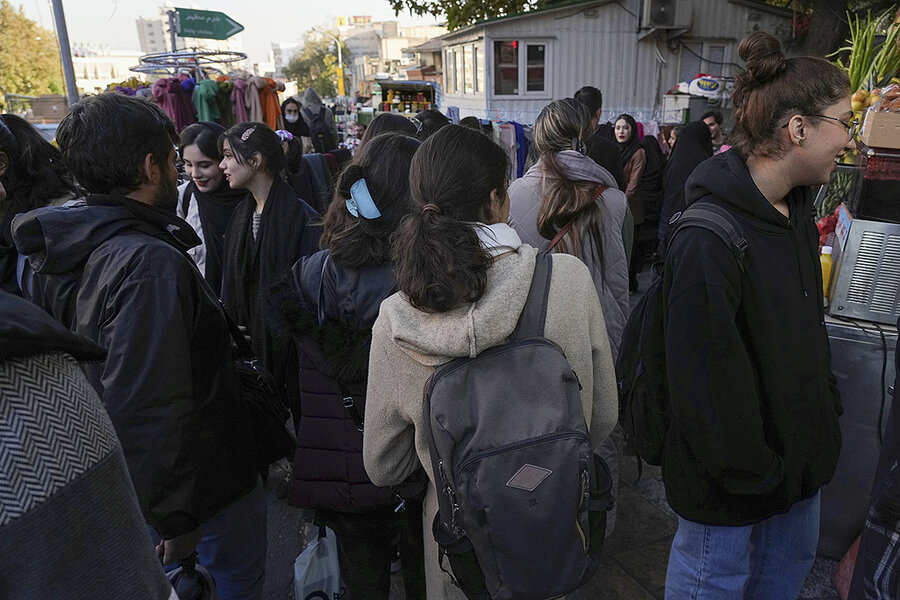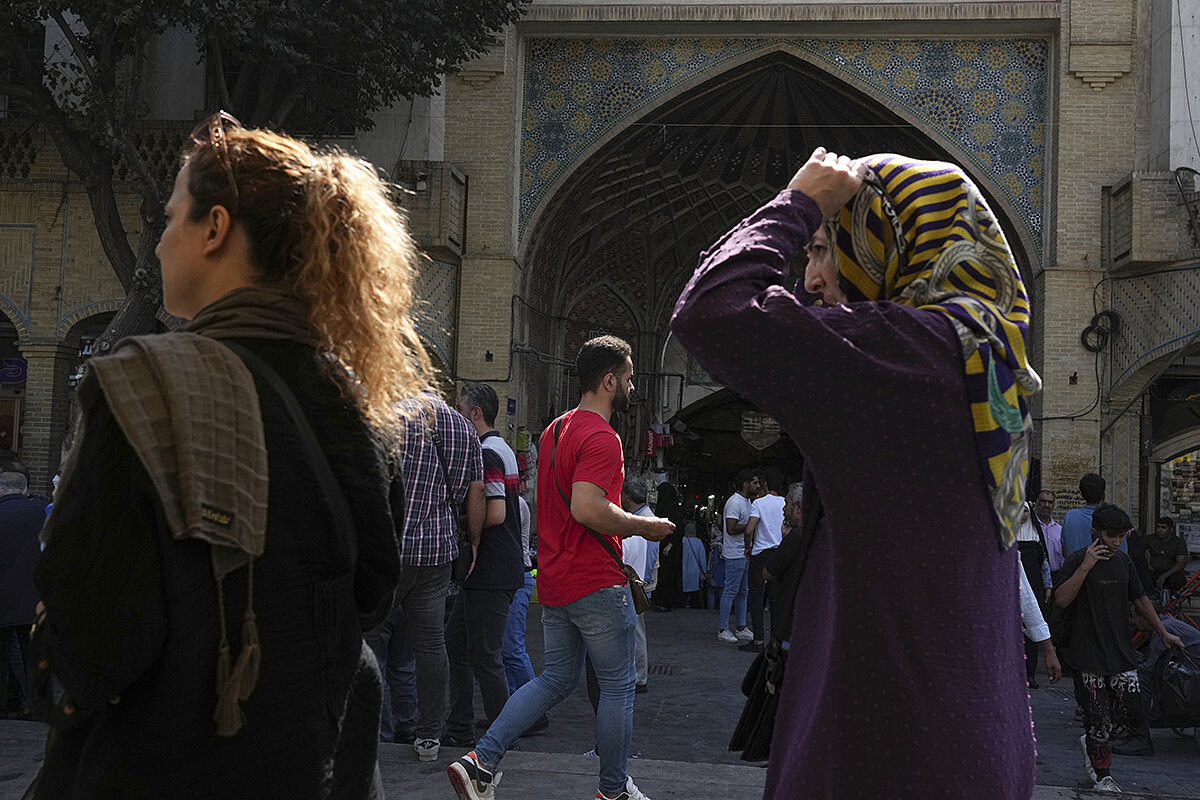Have Iran’s hard-liners lost the battle over women’s headscarves?
Loading...
| LONDON
The veteran schoolteacher will never forget the first time she broke Iranian law by venturing into public without her head covered, and felt the wind in her hair.
Widespread protests had been raging for three months, led by women and girls in an unprecedented wave of discontent that swept through scores of Iranian cities.
The catalyst was the mid-September death in custody of 22-year-old Mahsa Amini, who had been detained by Iran’s so-called morality police, allegedly for showing too much hair.
Why We Wrote This
A story focused onThe women-led protests that swept Iran last fall were brutally suppressed. But for a range of reasons – protesting the regime, reclaiming agency – women are ignoring laws requiring the hijab, creating a dilemma for hard-liners.
In response, Iranian women burned their headscarves in public and let their hair down. And – as the protests widened, with women and men together at the barricades facing a crackdown that reportedly left more than 500 dead and 20,000 detained – they demanded the toppling of the Islamist regime.
“I went to a mall [with] tears in my eyes,” says the primary school teacher, who gives the name Neda, recalling her first moments of breaking Iran’s strict hijab rules. “I can’t describe the feeling of air going through my hair.”
These days the 40-something professional routinely goes out with hair flowing: to the cafe, in the streets, and “everywhere.” “Now in my country it’s like feeling free, and brave,” Neda says. “A year ago, we even did not think it could happen at all.”
While the “Woman, Life, Freedom” street protests were largely snuffed out months ago, and stricter hijab rules have been enacted, legions of Iranian women like Neda are still refusing to wear hijab in public. That has left Iranian hard-liners scrambling to find ways to stanch and reverse this enduring defiance, which they deem an existential threat to the 1979 Islamic Revolution.
Debate over enforcement
A new law now before Iran’s Majlis, or parliament, would impose heavier fines and add punishments like restricting access to bank accounts and confiscating vehicles, as well as up to three years in prison for breaking hijab rules. But the law, scheduled to be debated in July, also prohibits physical coercion on the street, something that has caused an uproar among hard-liners. They reject it as too lenient, though the law was drafted by the office of President Ebrahim Raisi and the judiciary, both of which are controlled by hard-liners.
The angry debate in the hard-line camp illustrates the depth of the challenge that the defiance poses to the Islamic Republic. First, by women’s widespread repudiation of what hard-liners see as the core revolutionary ideal of hijab. Then, more broadly, by rejection of intrusive social control over all aspects of life that the regime has exercised for 44 years.
“The impact of these laws remains to be seen,” says Tara Sepehri-Far, a Washington-based Iran researcher for Human Rights Watch.
“There seems to be a debate within the establishment about how to enforce them in a way that doesn’t cause a lot of friction with the general public, the way that resulted in the death in custody of Mahsa Amini and the whole protest – but also keeps this [hijab] stranglehold, because this is very much a core issue for hard-liners,” says Ms. Sepehri-Far.
While the authors of the new “chastity and hijab” law aim to strike a balance that avoids igniting more protests, others demand more “robust” deterrence that would include physically painful forms such as lashing.
Hard-line lawmaker Alireza Abbasi, for example, called June 10 for the hijab law to be written so “no one would dare to remove their headscarves.”
Indeed, in mid-June uniformed and plainclothes security forces again raided coffee shops in several cities and beat customers over hijab rules. And the police chief of a northern resort province was filmed telling a subordinate, “Break the neck of anyone who breaks the [hijab] norms ... and I will take responsibility.”
One argument put forward by hard-liners is that the defiance plays into the hands of Iran’s external enemies who, in the words of one influential ayatollah, want “to rob us of the rule of religion.”
Supreme leader Ayatollah Ali Khamenei set the tone in early April, when he declared that rejecting hijab was religiously and politically “forbidden.” The “majority” of women who removed their headscarves, he said, were simple-minded and unaware that foreign spy agencies are operating “behind the scenes.”
“Those [anti-hijab] campaigns seek to preoccupy the minds of our youths with sensual urges,” warned Mr. Abbasi, “so that they will have no room to pursue missiles, the nuclear program, and knowledge-based technology.”
Still, protesting Iranian women from the start have rejected such claims of foreign meddling, just as they say any new law is incapable of reversing the achievements of their push for greater freedoms.
“This is a losing battle”
The scale of hijab rejection varies from neighborhood to neighborhood, city to city. But support for compulsory hijab has been dropping at least since 2018, when the Center for Strategic Studies, under then-President Hassan Rouhani, a relatively moderate cleric, surveyed women and men about their views.
Officials and hard-liners with access to data “are likely more aware than us about how much of a losing battle this [hijab] has been,” says Ms. Sepehri-Far. “This is a downward trend; this is a losing battle.”
And for women who continue to refuse to wear the hijab in public – up to 70% in some districts of Tehran, according to anecdotal accounts – their reasons range from displaying discontent toward the regime to reclaiming agency over the dress code.
“It is much more nuanced and multilayered than just refusing to wear hijab. ... [It’s] against a patriarchal society as well as a very abusive state,” says Ms. Sepehri-Far. “What has changed and transformed is a very precious gain and understanding that I very much doubt can be reversed through these laws.”
Stepping into the debate was the reformist former president, Mohammad Khatami, who sought to lessen hijab as an all-or-nothing revolutionary issue.
“Hijab differs from chastity,” Mr. Khatami told reformist women in Tehran. “We do endorse a chastity-oriented society, but that does not mean that we should equate chastity with hijab, and impose the latter.”
Those words sparked the ire of Hossein Shariatmadari, editor of the hard-line Kayhan newspaper, who is appointed by the supreme leader and who lambasted Mr. Khatami as an “ignorant, hateful, and populist cleric.”
“Not wearing the hijab is equal to nudity, as it cannot end in removing the headscarf alone,” wrote Mr. Shariatmadari.
“Change ... takes time”
Such framing could not be further from the experience of women like Neda, who remains in awe of the scale of change she has witnessed. In a single week this month, the teacher has received three official warnings by text message to cover up, owing to traffic cameras that now flag license plate numbers with long-haired vehicle occupants.
“I can see these teen girls from the school near our house; they take off their hijab when they come out of school,” says Neda. “Some families don’t want to change and force their daughters to wear hijab. ... [But] you cannot find a place where all women have hijab or don’t have it. They have just learned to be in the same place with each other.”
And she adds, “I believe the younger generation is brave enough to change things, but it takes time.”
That generation includes Nazanin, a 30-something architect who admits it is “really getting harder” to not wear a headscarf, “because it has become a symbol of civil disobedience, and you are not safe. All the time I feel like someone will come from behind my back and catch me.”
She ticks off the risks for women, which include fines or arrest, being banned from leaving the country, and deprivation of the rights of citizenship, such as a license. Cars are threatened with confiscation. And Nazanin was recently refused a ride by a taxi driver, who said he would be fined if she rode without covering her hair.
But she also takes heart in the profound experience of the protests – and the hijab disobedience they solidified.
“Those days are not something that I can ever forget, a combination of sadness and fear, at the same time with a sense of hope, courage, and love for people,” says Nazanin. The strangest thing, she says, was a first-ever feeling that the regime was “defeatable” and that “people can still be influential.”
“The most enjoyable part is that, despite all these brutalities, I see and experience so much courage,” says Nazanin. Still, the problems are not solved, “so there’s no reason for protests to end,” she says.
“People who become aware will not go back. ... The one who has experienced freedom cannot go back,” she says. “If there was no hope for change, so many people would not have risked their lives for it.
“The fire is just under the ashes, and ignites with the smallest spark.”
An Iranian researcher contributed to this report.









